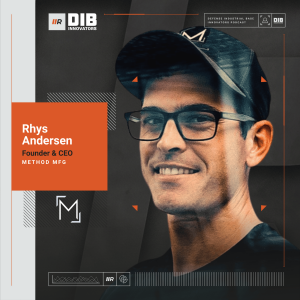
Thursday May 15, 2025
EP 63 — Method MFG’s Rhys Andersen on Bootstrapping a Machine Shop into Aerospace Manufacturing
When Rhys Andersen, Founder & CEO at Method MFG, moved to Texas with an architecture degree, he never imagined he'd end up machining components for spacesuits and rockets. Yet his journey from welding to founding his company exemplifies the untapped potential in American manufacturing. By combining cutting-edge technology with a focus on upskilling his entire team, Rhys has created a manufacturing environment that more closely resembles a tech company than a traditional machine shop — with white walls, white floors, and sophisticated software driving everything from quoting to production.
Rhys also shares with Dave his practical experience building a bootstrapped manufacturing company servicing aerospace and defense clients, including his counterintuitive approach to workforce development and the technologies revolutionizing production. His insights demonstrate why manufacturing's image problem is holding back America's industrial base, and how rebranding machining as the tech profession it truly is could help solve critical workforce shortages.
Topics discussed:
- Bootstrapping a capital-intensive manufacturing business by purchasing used equipment at a fraction of the cost for new pieces, while supplementing income through with other work to fund the company's early growth.
- The transformation of machining into a tech profession where white-collar programmers operate sophisticated 5-axis equipment and automation cells rather than traditional machine operators.
- Creating comprehensive cross-training programs to eliminate single points of failure by ensuring every machinist can program and operate the company's most sophisticated equipment.
- Leveraging technology as a multiplier through automation cells with robots that can change their own end effectors to handle everything from small vises to 900 kg pallets for unattended overnight production.
- The critical role of process documentation using iPads in the shop to capture setup photos and detailed notes, creating an institutional knowledge repository that prevents "reinventing the wheel" with repeat jobs.
- Strategic vertical integration decisions like building an in-house anodizing line to control quality and turnaround times for quick-turn aerospace components rather than relying on external vendors.
- Managing complex stress patterns in large aerospace components by creating strategic relief cuts and adapting clamping approaches to ensure finished parts maintain tolerance despite internal material stresses.
- The potential of AI-driven programming to automate routine aspects of CAM while allowing machinists to focus on more creative problem-solving and complex machining strategies.
- Rebranding manufacturing careers through educational partnerships showing students that modern machining involves sophisticated software, 5-axis programming, and automation rather than traditional manual labor.
No comments yet. Be the first to say something!